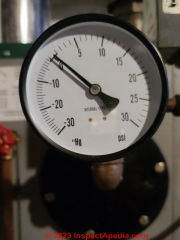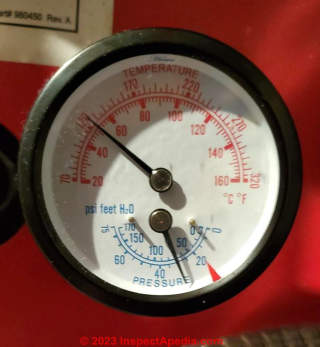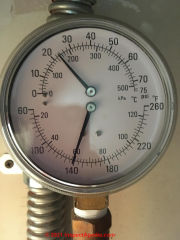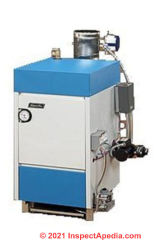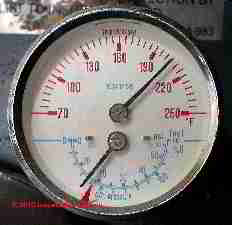 Heating Boiler Gauges
Heating Boiler Gauges
Types, location, uses & how to read the temperature & pressure gauge on a hydronic (hot water) boiler
- POST a QUESTION or COMMENT about gauges on hot water heating system boilers
Heating boiler gauges: this article describes the combination pressure & temperature gauge found on most hydronic (hot water) heating systems. We also illustrate pressure gauges found on low pressure steam system boilers.
For both hot water heat and steam heat, the boiler gauge gives helpful temperature or pressure readings that tell us if the boiler is operating normally.
The same pressure and temperature readings at a boiler can help diagnose problems such as TP valve leaks, cold radiators, and even boiler or heating system piping leaks. We give normal heating boiler pressure and temperature numbers and we explain what variations from these data signify.
InspectAPedia tolerates no conflicts of interest. We have no relationship with advertisers, products, or services discussed at this website.
- Daniel Friedman, Publisher/Editor/Author - See WHO ARE WE?
Heating Boiler Temperature & Pressure Gauge Guide
 Here we describe both steam heating boiler pressure gauges and pressure readings, and hot water heating pressure and temperature gauges.
Here we describe both steam heating boiler pressure gauges and pressure readings, and hot water heating pressure and temperature gauges.
At page top and just above we show a typical hot water (hydronic) boiler pressure gauge and its location on the front of the boiler.
[Click to enlarge any image]
Typical pressure for a hot water (hydronic) residential boiler serving a two story home would show 12 psi cold, and less than 30 psi hot. Over 30 psi boiler pressure will cause the pressure relief valve to open.
Typical operating temperature settings on a boiler call for a Low temperature (boiler cut-in) between 120 and 160 °F.
Typical operating temperatures on a hydronic boiler call for a high temperature (boiler cuts off) of 180-200 °F.
Over 200 degrees F. we're at risk of spilling at the pressure temperature relief valve.
Typical operating temperature observed at the gauge will be below the high, and can be as low as nighttime room temperature in non-heating season if no tankless coil is in use.
The temperature/pressure gauge may help in checking for normal conditions before and during boiler operation.
However the boiler pressure or temperature gauge can be wrong!
This boiler pressure and temperature gauge shows a typical in-boiler pressure of under 20 psi, and a temperature of about 190 °F. (The boiler had just cut off on a heating cycle.)
Typical boiler pressure on a residential ("low pressure") steam heating boiler (shown below) will be very low, usually under 1 psi. Larger and commercial steam boilers might operate at much higher pressures.
Normal Hot and Cold Operating Pressures of Residential Hydronic (hot water) Heating Boilers
On a residential heating boiler the automatic water-feeder/pressure reducing valve that automatically provides makeup water to the heating boiler if pressure drops below 12 psi. So 12 psi is the typical "cold" pressure for residential boilers.
If your building is taller than two floors, the installer may have needed to boost the starting "cold" water pressure for your boiler to overcome the hot water distribution piping head pressure - otherwise your heating circulators may not be able to circulate hot water.
At PUMP, WATER PRESSURE BOOSTING
we explain the relationship between building height and water pressure, and we illustrate the water pressure decrease in building water supply piping with building height. But a look at the basement water pressures in this illustration also explains the pressures that a basement located hot water heating circulator pump has to overcome.
12 psi is for typical U.S. / Canadian residential heating systems normal cold temperature starting pressure. U.K. and european heating systems should be pressurized to between 1 and 1.5 bar - cold.
20 psi is typical for U.S. / Canadian residential heating systems normal hot operating temperature, up to just under 30 psi, depending on the high-limit temperature setting on the boiler limit control.
If we set the boiler high-limit much over 210, on many residential systems the system pressure will exceed 30 psi and we'll see water leaking from the pressure/temperature relief valve - ultimately an unsafe condition.
Pressure and Temperature gauge On heating boilers: this gauge displays the heating boiler internal pressure and temperature.

Typical pressure for a residential boiler serving a two story home would show 12 psi cold, and less than 30 psi hot.
Over 30 psi boiler pressure will cause the pressure relief valve to open.
Typical hydronic heating boiler operating temperature
settings are LO-120-160 HI-180-200 °F. At 200 °F. we'll see should see pressure under 30 psi.
Typical operating temperature observed at the gauge will be below the high, and can be as low as
nighttime room temperature in non-heating season if no tankless coil is in use. The temperature/pressure gauge may help in checking for
normal conditions before and during boiler operation. However the gauge can be wrong!)
Normal Gauge Pressures on Residential Steam Boilers
Because residential steam boilers, also usually "low pressure steam boilers" operate around the 0.2 to 0.5 psi range, the pressure reading you'll see on a typical steam boiler will be quite close to the zero mark.
Details about steam boiler pressures, gauges, and controls are at STEAM BOILER PRESSURE
...
Reader Comments, Questions & Answers About The Article Above
Below you will find questions and answers previously posted on this page at its page bottom reader comment box.
Reader Q&A - also see RECOMMENDED ARTICLES & FAQs
On 2022-12-30 by InspectApedia Publisher - how do i get the temp down in weil-mclain boiler
@cheryl,
That sounds as if the circumference is continuing to run. Be sure to turn off power to the circulator. Then it will cool down.
On 2022-12-30 by cheryl
no power (turned off) to the boiler but the circulating pump is 218 degrees too hot to remove safely and replace. its been off for 10 hours and not cooling down. how do i get the temp down? weil-mclain boiler bell&Gossett circulator pump model nsf-22
On 2022-12-28 by Vanessa
@InspectApedia Publisher,
Thank you so much for your help!!
On 2022-12-26 by InspectApedia Publisher - Crown boiler PSI seems high
@Vanessa,
Your pressure gauge is sitting right at 30 psi.
1. IF you do NOT see spilling at the temperature-relief valve then that's good news - this isn't an emergency.
2. IF you took that photo when the boiler was up to full operating temperature, then that's "normal" pressure - considering that these gauges are not precise - not lab-grade instruments.
3. Normal boiler pressures for a residential hot water heating boiler in a typical 2-story home are
- 12 psi when the boiler is cold
- just under 30 psi when the boiler is at its hottest
Check the HI setting on the boiler aquastat - it should be set to 200 degF or a bit lower - often a tech will leave it at 180F.
Details are at
AQUASTAT HI LO DIFF SETTINGS
https://inspectapedia.com/heat/Aquastat_Settings.php
Let me know if you've got another concern like leaks at the temperature/pressure relief valve.
On 2022-12-26 by Vanessa
It seems like the temperature on my Crown boiler is ok, but the PSI seems high. We only have our thermostat set to 66 degrees and the house is cold. Is there something we can do to help decrease the psi? Do we need to call a repair person?
On 2022-11-15 by InspectApedia (Editor)
@Douglas,
I don't see a question. If you are saying that your boiler pressure never changes even though the burner runs and the boiler gets hot, I suspect the gauge is defective.
On 2022-11-13 by Douglas
Pressure constant at 12 pounds. Shutoff temp about 160
On 2022-09-12 by InspectApedia-911 (mod) - water pressure in the boiler is at 40 psi with the boiler water being cold
@GEORGE.B,
Yes, don't even turn on the boiler before you know its cold-pressure is correct - probably 12 psi.
Either you've had street level pressure, bypassing your pressure regulator/water feeder or your pressure regulator is improperly installed or damaged.
Have you tried draining pressure from the system until it gets back to 12 psi?
Do that and if pressure stays there you're good to go.
Also don't rule out a pressure gauge that's stuck.
On 2022-09-12 by GEORGE.B
Hello, I just drained out my hot water boiler, this is a three story house. I installed a new pressure reducing valve which came preset at 12 psi. I also replaced the pressure relief valve and expansion tank is also at set at 12 psi, the old one was full of water.
I filled out the the boiler and bled the air from the radiators, but my water pressure in the boiler is at 40 psi with the boiler water being cold. Am I going to have the same problem with constantly losing water? thank you- Please help!
On 2022-02-28 by Inspectapedia Com Moderator
@Anonymous,
Glad to assist - keep me posted and ask for more help if needed after you read that PDF file. In the Article Index, you'll find extensive information about aquastats, what they are, how they work, etc.
On 2022-02-28 by Anonymous
@Inspectapedia Com Moderator,
Thanks! I will definitely read that aquastat page you recommended. I know nothing about aquastat so it will probably take me some time to research and understand it. I will read about it and try to figure out how it might apply in my situation. I appreciate the help.
On 2022-02-28 by Inspectapedia Com Moderator - failed expansion tank can cause abnormally high pressures
@MikeB,
As long as the pressure is under 30 psi - 28psi is typical - when the boiler is at its highest temperature (somewhere below 200 degF) your residential hydronic boiler system is working normally.
I agree that a failed expansion tank can cause abnormally high pressures and once you exceed 30 psi, the relief valve should spill
Please take a look at
AQUASTAT HI LO DIFF SETTINGS
On 2022-02-28 by MikeB
My "typical" 2-story residential home's hydronic boiler system (Weil McLain, 10 years old) is at a 12 psi resting state when cold (good), and as the boiler runs and the temperature goes up so does the pressure in these increments: 21 psi at 160 degrees, 23 psi at 170 degrees, 24 psi at 175 degrees... is that ok? This is after I replaced the expansion tank this morning. This is better than it was.
Prior to my replacing the expansion tank this morning, the psi had been increasing at a faster rate (and nearly reaching 30 psi)... e.g. 25 psi at 160 degrees, and around 28-29 psi at 170-175 degrees at which point I shut boiler off because I did not want to exceed 30 psi and blow the relief valve.
Also, importantly, I believe I have RULED OUT the possibility of a leaky combination "pressure reducing valve/backflow preventer" because in an earlier test when I turned off the water line completely that feeds the autofill/backflow (ie. zero water could be added) I STILL had that faster pressure increased I'd just mentioned.
At this point, I'm hoping I'm OK with the first incremental changes in pressure I mentioned at the beginning of this post. Does it sound OK or normal, or should I be able to get up to 180 degrees but only be at 20-22psi? I want to know if 24psi for 174 degrees is normal.
Finally, I am not sure if my boiler would shut off at 180 degrees on its own, or some higher number. I don't know what else could cause higher-than-ideal psi in my system at the temperatures I've mentioned. Any thoughts would be hugely appreciated.
On 2022-12-23 by InspectApedia (Editor) - What's the right water temperature setting for a Hydronic Boiler
@Nathan,
Your boiler will be as low as room temperature when it hasn't run in some time and will heat up to somewhere under 30PSI at its hottest. If the temperature exceeds thirties the pressure temperature relief valve will open to avoid risking a boiler explosion. You don't suck the boiler pressure you set the boiler operating temperatures.
If the boiler starting pressure when it's cold is higher than 12PSI that could be your problem.
On 2022-12-23 by Nathan
Whats the right water temperature setting for a Hydronic Boiler for a two-family house in Brooklyn New York ? And why I can't keep my boiler at 12PSI it keeps going past 30 PSI my expansion tank is new
On 2021-11-02 by (mod)
@Jerry H,
If it's an old boiler it may use a standing pilot that is normally always lit and not an igniter.
If you can't keep the pilot light lit, the problem may be a bad thermocouple.
See the diagnostic steps starting at
DIAGNOSE & FIX HEATING PROBLEMS-BOILER
On 2021-11-02 by Jerry H
Good morning, I have an old Kool-Base hot water boiler that is reading 12psi cold, and no temperature at all. Pilot like is lit, thermostat is on 85 degrees, and can not get furnace to kick on. It is so old, I'm not even sure I can locate the ignitor? Is it right next to the pilot light?
On 2021-10-14 by (mod)
@Julia,
Continuing:
If you don't have the manual for your boiler see the Argo boiler manual downloads and contact information found at
ECR INTERNATIONAL BOILERS HVAC AGE MANUALS CONTACT
On 2021-10-14 by (mod) - psi and the temperature seeming high according to standard
@Julia,
An expansion tank absorbs the initial pressure increase in a hydronic heating system so as to avoid dumping the pressure/temperature relief valve. But the expansion tank has NOTHING to do with the ultimate temperature and pressure that the system will reach. Those are set by the aquastat or control over the boiler's temperature.
As long as you're seeing pressures that are below 30 psi (the typical PRV dump pressure) and temperatures below 200F your system is probably operating normally.
On 2021-10-14 by Julia
Good day! I am writing to see if I might get some feedback if someone is available. Just got the system up and running yesterday, a 16 year old ARGO hydronic electric boiler. The house is comfortable today, and the temperature gage has been consistent.
I have a bit of concern about the psi and the temperature seeming high according to standard said I have read about online.
And I cannot remember what the cages were reading last year. Psi is 22, temperature is 140, steady and consistent. Would anyone advise perhaps a new expansion tank? Thank you!
On 2021-09-06 by (mod) - change the gauge when there is moisture on the inside of the gauge glass
@Janis S,
Yes you should have your heating service tech change out that leaky gauge.
It's not usually an emergency, so you can schedule that for your next service call - before the oncoming heating season.
The concern is that water in the gauge tells us that there is already an internal leak in the gauge.
Ongoing corrosion, or temperature change that cracks the gauge glass, or even simply accidentally whacking the leaky pressure gauge could result in its bursting;
If that happens the result can be a boiler room or basement flood, loss of heat, and if the boiler is quite hot, even a scalding burn if someone is nearby.
I've seen leaky gauges left in place for years with nothing worse happening than that the gauge becomes un-readable. But on my boiler, rather than risk the dangers I list above, I'd have the gauge replaced.
On 2021-09-06 by Janis S
Do I need to change the gage when there is moisture on the inside of the gage glass but the gage indicates correct temp and pressure readings? Thank you. Janis
On 2021-02-24 by (mod)
@Jpusfinc, in the article index you will find several articles on repairing Airbound heating systems and others on no heat problems for hot water or hydronic heating boiler systems. In the latter case besides resolving the Airbound question you need to look at the thermostat, thermostat wiring, circulator relay, and circulator to see if the circulator is even running.
On 2021-02-24 by Jpusfinc
I have a crown boiler the pipes in basement get hot the temperature shows temperature but the water gauge shows 0 psi I try bleeding the radiators and filling with water no air or water comes out I replaced pressure relief valve and try filling no water getting to radiator but boiler is filled with water please help. Thank you.
On 2021-02-19 by (mod)
Forgive me Set but I don't know what a "two-gauge system" is
If you are referring to boiler gauges like the one shown at page top, one scale reads pressure and the other temperature.
We don't set gauges, we set the boiler temperature and pressure on the boiler controls - such as the aquastat that sets temperature, and the starting pressure when the boiler is cold, set at the water feeder valve.
Some boiler gauges also include a manual pointer that can be set as a reference point. It does nothing to the boiler, it just provides a reference point.
On 2021-02-19 by Set gages
On a two gage system what should the settings
On 2020-12-12 by (mod)
Mark:
The aquastat that controls temperatures on a typical Sentry Slant/Fin S-120, like the model we show below, is the gray box shown at upper right in the image.
210 deg F is too high and risks spilling at the temperature-relief valve: a condition that can make the boiler unsafe.
See AQUASTAT HI LO DIFF SETTINGS inspectapedia.com/heat/Aquastat_Settings.php
On 2020-12-12 by Mark
I can't find where the furnace temperature control is. The temperature is 210* I want to lower it to around 180* its an older sentry slant /fin model number S-120 DP ??? Any advice would be appreciated. Thank you
On 2020-11-28 by (mod) - where to buy a replacement boiler gauge
Plumbing suppliers, heating suppliers, online vendors, even Amazon.com all stock these boiler pressure and temperature gauges as it's a very common part.
Just check the pipe size, typically 1/4", of the threaded base of your boiler gauge.
On 2020-11-28 by clint collingwood
I repete where can i buy a replacement pressure -tempurture guage? @clint collingwood,
temperture
Where can I buy a repiacement guage?
On 2020-11-01 by (mod) - Typical cost of a residential heating boiler gauge - part vs labor: steps in gauge replacement
Thanks for a helpful question, SS: Typical cost of a residential heating boiler gauge;
A typical boiler gauge is about $30. to $40. U.S.
But it's helpful to understand what's needed to replace the gauge - let me outline it:
1. Drive to the site - travel time, in my truck stocked with repair and replacement costs - an overhead to the heating company
2. Talk to the customer to explain what's coming, then turn off the heating boiler and wait .... and wait ... for the boiler to cool down enough to work on it safely
3. When the boiler is cool enough to touch (water's just warm, not hot or scalding) bring in your drain hose, connect to the boiler drain, open the boiler drain, drain to an acceptable disposal point
4. Close the boiler drain, remove the drain hose.
5. With pressure off the system and boiler drained down at least to below the gauge mounting port, remove the old gauge
6. Clean up the boiler tapping, then prep the new gauge with a bit of teflon tape or equivalent, and screw it in
7 Re-fill the boiler
8. Turn heat on
9. Inspect the boiler for leaks including at the boiler drain. It's an ugly truth but too often a drain that's not touched for years, when used, spits out a dried-out stop valve washer and then can't be shut off. If the tech finds this she's got to be prepared to drain the system again and replace or repair the drain valve.
10. Purge the excess air from the system - this can take some time depending on what isolation valves were present, used, functional,
11. With boiler up to temp, inspect for leaks and
12. confirm that every heating zone is working - don't leave the customer with an air-bound heating zone or there'll be an upset customer and a call-back for more work
It's been years so I've probably forgot something (like adding back boiler antifreeze in some systems)
But you can see that what you're paying for is not the part but the time and knowledge the service tech has to have to do the job right and not leave you with leaks or no heat in cold weather.
By the way, what cost were you quoted?
On 2020-11-01 by ss
what is the cost of replacing one of these gauges, the pseg guy came to check mine out and said the seal was broken, as in there was water in the gauge you couldn't read the numbers. then quoted and absurd amount, any ball park figures for the coast of parts?
On 2020-05-07 by (mod) -
Way to go -
waterlogged expansion tank
Still starting at 20 psi cold is a bit high
On 2020-05-07 by JH - discovered waterlogged boiler expansion tank
Think I figured it out. Expansion tank was FULL after all.
On 2020-05-07 by (mod) -
Watch out: Also see the diagnostics and safety warnings beginning at
RELIEF VALVE LEAKS
On 2020-05-07 by (mod) - relief valve leaks when boiler gets up to high temperature
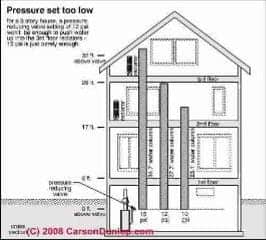 20 psi cold is a bit high- typically we'd see 12, at a hydronic boiler. 12 psi is usually NOT enough to get hot water up 3 floors. But 15 psi is enough. So 20 is probably too high.
20 psi cold is a bit high- typically we'd see 12, at a hydronic boiler. 12 psi is usually NOT enough to get hot water up 3 floors. But 15 psi is enough. So 20 is probably too high.
Check also the temperature: if it's going above 200F then that's the problem.
At EXPANSION TANK PRESSURE ADJUSTMENT
we discuss setting the heating boiler expansion tank pressure to accommodate tall buildings
On 2020-05-07 by JH
I am stumped. Weil McLain hot water boiler is filling to 20lbs PSI cold. Three storey home.
When calling for heat the pressure goes up to 30PSI and PRV bleeds. Expansion tank (old 4 foot long tank not bladder) seems to be taking some of the water. Any ideas?
On 2020-04-18 - by (mod) - the temperature gauge maxes out, 250 F
Jerry,
Watch out: That sounds very dangerous to me. At 250F if your relief valve on the boiler is not spilling you risk a BLEVE explosion.
Turn off the system and call for repair.
On 2020-04-17 by Jerry
My weil mclain CG boiler temp keeps rising until there is loud banging in the pipes...the temp gauge maxes out, 250f.
can't seem to get the temp to stop rising, autostat is set to 180 and the psi is around 15. Any ideas why temp keeps rising / suggestions on what to check and how to address?
Thanks in advance!
On 2020-03-26 - by (mod) -
Jay
If you've got heat then I suspect that the gauge pressure sensor port is debris-plugged.
On 2020-03-25 by Jay trinidad
Benchmark 1000 boiler, my gauge pressure is zero while my temptress on same Guage is 160 F.
On 2020-02-23 - by (mod) - no water pressure in boiler? Check the gauge itself
Bill:
Because sometimes the gauge itself can be debris-clogged and not register pressure, you may need to check elsewhere to find out if indeed your boiler and the heat piping are not filled with water.
Go to a high location in the building where there's an air bleeder and open the valve (carefully so as not to get scalded) to see if water comes out - if so then there is probably water in the system and the lockout may be due to a burner or safety-reset issue.
If the boiler really has no water then a low water cutoff could be shutting down the boiler to prevent damage or an unsafe condition or even a BLEVE explosion.
So if in doubt leave the system off and call for repair.
Let me know.
On 2020-02-23 by Bill
I have no pressure on my gauge boiler keeps locking out
On 2020-02-12 - by (mod) - boiler pressure gauge not working
Agree, Brad, the pressure gauge would need to be able to sense water pressure from the boiler.
But are you sure we're seeing an original installation by the manufacturer?
It's not likely that the manufacturer would install a temperature/pressure gauge in a sensor well that is intended only for temperature sensors.
Attach a photo of your gauge.
On 2020-02-12 by Brad
My hydronic heat boiler has a combination temp/press gauge installed in a sealed well.
The temperature seems to work fine, but the pressure gauge has never move off zero. How would it work in a sealed well? I'm thinking of installing a separate pressure gauge on the system that is not in a sealed well.
On 2020-01-02 - by (mod) -
180 F is a common upper limit set on heating boiler systems by service technicians.
On 2019-12-31 by George Dombakly
temperature on my Tridicator is 180 degrees farenheit. Is that too hot for a Weil-Mclane 150,000 BTU boiler that is 35 years old with a Honeywell R7184U Transformer ?
On 2019-11-17 - by (mod) - adjust water pressure to boiler for taller building
OK so setting the boiler COLD pressure to 12 psi would be a normal setting and is the factory defect pressure when you install a water feeder valve used on heating boilers in North America.
If you have the normal controls on your heating boiler and if they are working, you should not need to make an adjustment to the system's pressure. It should already be correct at 12 psi cold and running somewhere under 30 psi when the boiler is up to full operating temperature.
Hydronic (hot water heat - not steam and not air) heating system water-feeder / pressure reducer valves are described in detail
at PRESSURE REDUCING VALVES and water feeder valves
Please take a look and ask followup questions as needed.
On 2019-11-17 by Mary
Yes I have a one story house with a close hydronic in floor heating system just want to verify at what pressure that should be set ? This system runs off a natural gas water heater of 75 gallons.
...
Continue reading at BOILER CONTROLS & SWITCHES -home, or select a topic from the closely-related articles below, or see the complete ARTICLE INDEX.
Or see GAUGES, HYDRONIC BOILER FAQs - questions & answers posted originally at this page
Or see these
Recommended Articles
- BOILER CONTROLS & SWITCHES
- BOILERS, HEATING - home
- EXPANSION TANKS
- GAUGES ON HEATING EQUIPMENT
- PRESSURE & TEMPERATURE SETTINGS, CONTROLS
- STEAM BOILER PRESSURE
- STEAM HEATING SYSTEMS & CONTROLS
Suggested citation for this web page
GAUGES, HYDRONIC BOILER at InspectApedia.com - online encyclopedia of building & environmental inspection, testing, diagnosis, repair, & problem prevention advice.
Or see this
INDEX to RELATED ARTICLES: ARTICLE INDEX to HEATING BOILERS
Or use the SEARCH BOX found below to Ask a Question or Search InspectApedia
Ask a Question or Search InspectApedia
Try the search box just below, or if you prefer, post a question or comment in the Comments box below and we will respond promptly.
Search the InspectApedia website
Note: appearance of your Comment below may be delayed: if your comment contains an image, photograph, web link, or text that looks to the software as if it might be a web link, your posting will appear after it has been approved by a moderator. Apologies for the delay.
Only one image can be added per comment but you can post as many comments, and therefore images, as you like.
You will not receive a notification when a response to your question has been posted.
Please bookmark this page to make it easy for you to check back for our response.
IF above you see "Comment Form is loading comments..." then COMMENT BOX - countable.ca / bawkbox.com IS NOT WORKING.
In any case you are welcome to send an email directly to us at InspectApedia.com at editor@inspectApedia.com
We'll reply to you directly. Please help us help you by noting, in your email, the URL of the InspectApedia page where you wanted to comment.
Citations & References
In addition to any citations in the article above, a full list is available on request.
- [1] Power Technology and Engineering (formerly Hydrotechnical Construction), Volume 43, Number 4, 247-250, DOI: 10.1007/s10749-010-0105-4 - Thermal Power Stations, Temperature regime for damaged steam superheater coils, V. A. Bogachev (this is a PDF file - if you can't find contact SpringerLeak)
- [2] "Deaerator", Wikipedia, web search 12/18/11. Quoting:
The deaerators in the steam generating systems of most thermal power plants use low pressure steam obtained from an extraction point in their steam turbine system. However, the steam generators in many large industrial facilities such as petroleum refineries may use whatever low-pressure steam is available. - [3] Babcock & Wilcox Co. (2005). Steam: Its Generation and Use (41st ed.).
- [4] Thomas C. Elliott, Kao Chen, Robert Swanekamp (coauthors) (1997). Standard Handbook of Powerplant Engineering (2nd edition ed.). McGraw-Hill Professional. ISBN: 0-07-019435-1.
- Our recommended books about building & mechanical systems design, inspection, problem diagnosis, and repair, and about indoor environment and IAQ testing, diagnosis, and cleanup are at the InspectAPedia Bookstore. Also see our Book Reviews - InspectAPedia.
- Domestic and Commercial Oil Burners, Charles H. Burkhardt, McGraw Hill Book Company, New York 3rd Ed 1969.
- National Fuel Gas Code (Z223.1) $16.00 and National Fuel Gas Code Handbook (Z223.2) $47.00 American Gas Association (A.G.A.), 1515 Wilson Boulevard, Arlington, VA 22209 also available from National Fire Protection Association, Batterymarch Park, Quincy, MA 02269. Fundamentals of Gas Appliance Venting and Ventilation, 1985, American Gas Association Laboratories, Engineering Services Department. American Gas Association, 1515 Wilson Boulevard, Arlington, VA 22209. Catalog #XHO585. Reprinted 1989.
- The Steam Book, 1984, Training and Education Department, Fluid Handling Division, ITT [probably out of print, possibly available from several home inspection supply companies] Fuel Oil and Oil Heat Magazine, October 1990, offers an update,
- Principles of Steam Heating, $13.25 includes postage. Fuel oil & Oil Heat Magazine, 389 Passaic Ave., Fairfield, NJ 07004.
- The Lost Art of Steam Heating, Dan Holohan, 516-579-3046 FAX
- Principles of Steam Heating, Dan Holohan, technical editor of Fuel Oil and Oil Heat magazine, 389 Passaic Ave., Fairfield, NJ 07004 ($12.+1.25 postage/handling).
- "Residential Steam Heating Systems", Instructional Technologies Institute, Inc., 145 "D" Grassy Plain St., Bethel, CT 06801 800/227-1663 [home inspection training material] 1987
- "Residential Hydronic (circulating hot water) Heating Systems", Instructional Technologies Institute, Inc., 145 "D" Grassy Plain St., Bethel, CT 06801 800/227-1663 [home inspection training material] 1987
- "Warm Air Heating Systems". Instructional Technologies Institute, Inc., 145 "D" Grassy Plain St., Bethel, CT 06801 800/227-1663 [home inspection training material] 1987
- Heating, Ventilating, and Air Conditioning Volume I, Heating Fundamentals,
- Boilers, Boiler Conversions, James E. Brumbaugh, ISBN 0-672-23389-4 (v. 1) Volume II, Oil, Gas, and Coal Burners, Controls, Ducts, Piping, Valves, James E. Brumbaugh, ISBN 0-672-23390-7 (v. 2) Volume III, Radiant Heating, Water Heaters, Ventilation, Air Conditioning, Heat Pumps, Air Cleaners, James E. Brumbaugh, ISBN 0-672-23383-5 (v. 3) or ISBN 0-672-23380-0 (set) Special Sales Director, Macmillan Publishing Co., 866 Third Ave., New York, NY 10022. Macmillan Publishing Co., NY
- Installation Guide for Residential Hydronic Heating Systems
- Installation Guide #200, The Hydronics Institute, 35 Russo Place, Berkeley Heights, NJ 07922
- The ABC's of Retention Head Oil Burners, National Association of Oil Heat Service Managers, TM 115, National Old Timers' Association of the Energy Industry, PO Box 168, Mineola, NY 11501. (Excellent tips on spotting problems on oil-fired heating equipment. Booklet.)
- In addition to citations & references found in this article, see the research citations given at the end of the related articles found at our suggested
CONTINUE READING or RECOMMENDED ARTICLES.
- Carson, Dunlop & Associates Ltd., 120 Carlton Street Suite 407, Toronto ON M5A 4K2. Tel: (416) 964-9415 1-800-268-7070 Email: info@carsondunlop.com. Alan Carson is a past president of ASHI, the American Society of Home Inspectors.
Thanks to Alan Carson and Bob Dunlop, for permission for InspectAPedia to use text excerpts from The HOME REFERENCE BOOK - the Encyclopedia of Homes and to use illustrations from The ILLUSTRATED HOME .
Carson Dunlop Associates provides extensive home inspection education and report writing material. In gratitude we provide links to tsome Carson Dunlop Associates products and services.



